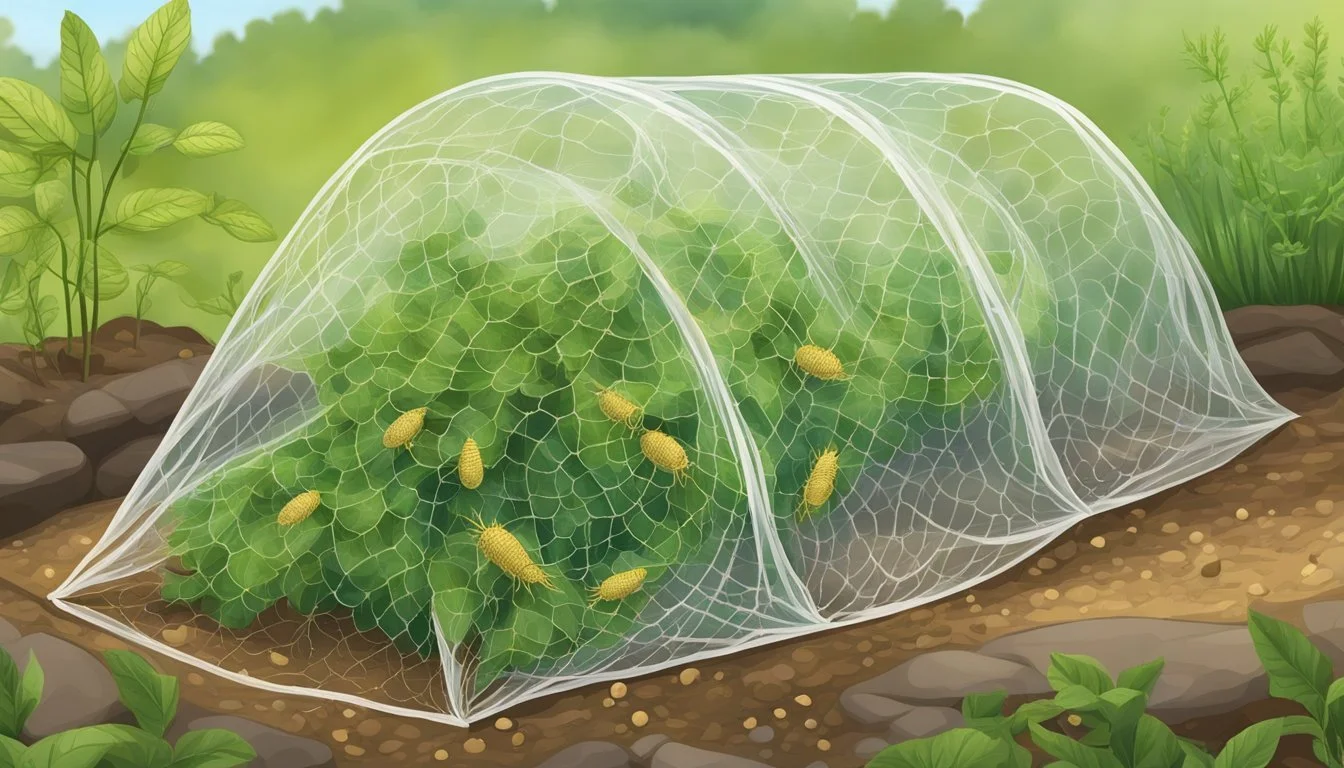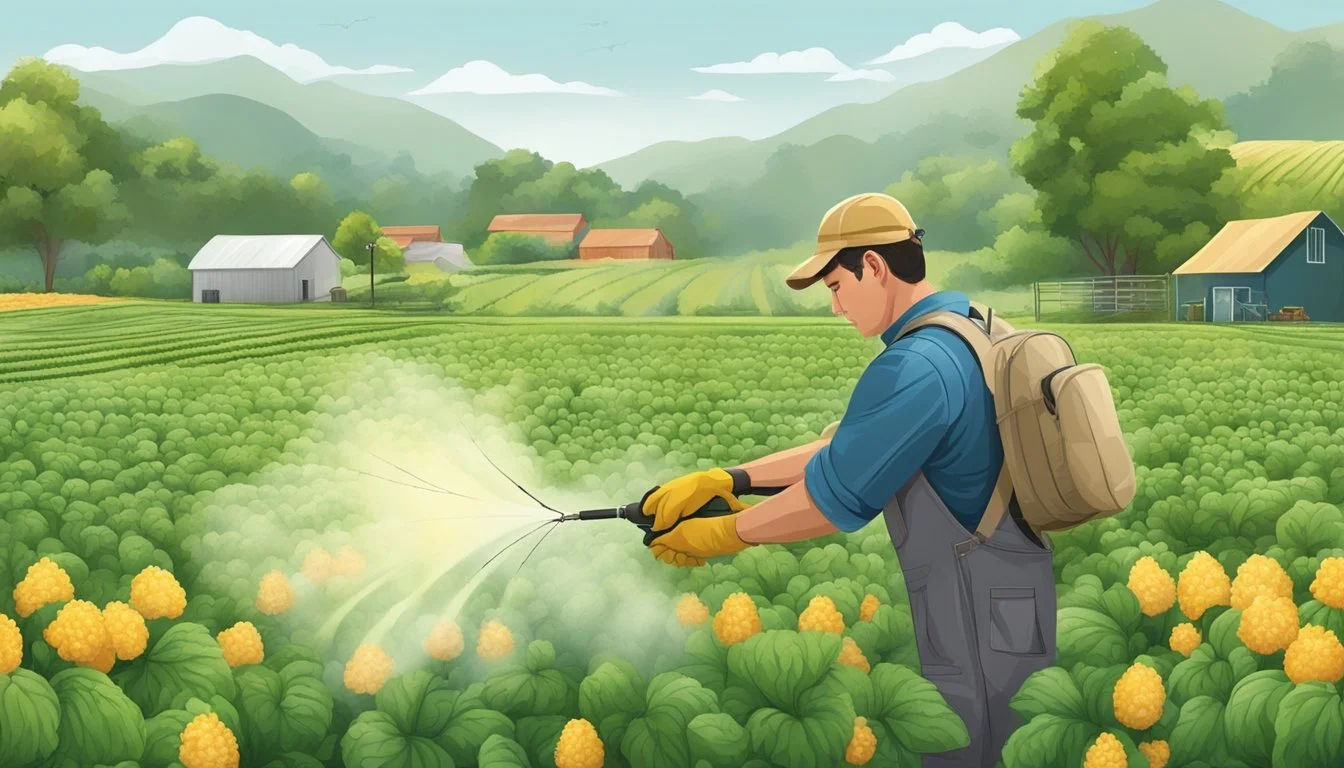Protecting Crops from Webworms
Effective Control Strategies
Webworms, the caterpillar form of a small moth, pose a significant risk to a variety of tree species during their feeding periods. These pests are especially known for creating conspicuous, unsightly webs at the tips of branches where they congregate in groups to feed on foliage. They can infest almost 90 species of trees, with a particular preference for trees like hickory, walnut, birch, cherry, and crabapple. Not only do these webs mar the aesthetic of trees, but severe infestations can also lead to the defoliation of large parts of a tree, albeit most mature trees can typically withstand this without serious damage.
Protecting crops from these pests involves understanding their life cycle. They overwinter as larvae or pupae and emerge in early spring as moths, which are nocturnal but may be seen flying out of foliage during the day. The moths lay their eggs in clusters, leading to a new generation of caterpillars that can affect trees. While mature trees can usually tolerate the feeding of webworms, young or weakened trees may suffer more serious consequences without intervention.
Effective management starts with early detection and physical removal of the webs when possible. Biological control measures, such as introducing natural predators, can also play a role in reducing webworm populations without the need for chemical treatments. In cases where these methods are insufficient, the targeted use of approved insecticides or treatments like dormant oil can help in controlling these pests while minimizing the impact on the environment and non-target species.
Understanding Webworms
Webworms, particularly the fall webworm, are caterpillars that transform into moths and are known for their web-like nests in trees. This section will focus on their distinguishing features, life cycle, and seasonal behavior patterns that impact crop health.
Characteristics of Webworm Species
The fall webworm, Hyphantria cunea, is a caterpillar that becomes a moth. They are recognized by their white, silk webs that often envelop the branches of trees. These caterpillars have a varied coloration, ranging from yellow to green, with hairs scattered across their bodies. The caterpillars are the damage-causing stage of the species, defoliating trees as they feed.
Lifecycle of Fall Webworms
The life cycle of fall webworms consists of four stages: eggs, larvae (caterpillar stage), pupa, and adult moth.
Eggs: They lay their eggs in clusters on the underside of leaves.
Larvae: Caterpillars hatch and immediately begin to spin webs for protection while feeding.
Pupa: After several weeks, the larvae enter the pupal stage, often in the soil or leaf litter.
Moth: Adult moths emerge and lay eggs, completing the cycle.
There can be more than one generation of fall webworms per year, particularly in warmer climates.
Seasonal Behavior Patterns
Fall webworms are most active during late summer and fall. This is when they become highly visible as they construct large webs on tree limbs to protect their colonies while feeding. The moths, conversely, are active at night and are less conspicuous. Their presence is marked by their nocturnal activity, where they mate and lay the next generation of eggs. During the day, adult moths are less active and may be found resting on the underside of leaves or in other sheltered areas.
Signs of Webworm Infestation
Detecting a webworm infestation early is crucial to protect trees and reduce the extent of damage. Knowing the signs helps in prompt and effective intervention.
Identifying Webworm Presence in Trees
Webworms are pests that create characteristic webs on the branches of trees as they feed on leaves. The initial signs of a webworm infestation include small, silky webs at the branch tips. As the webworms consume the foliage, these webs expand to enclose more of the branches and leaves, forming tent-like structures. The presence of these webs, especially during late summer and fall, is a clear indicator of webworm activity.
Assessing the Extent of Damage
The extent of damage caused by webworms can vary. They may cause significant defoliation, but for most healthy trees, this leaf loss is often not critical. However, if the infestation is severe and the foliage is extensively destroyed, it can weaken the tree over time. It's vital to inspect how widespread the webs are and whether the branches inside the webs are bare or hold a considerable amount of leaves still intact.
Cultural and Physical Control Measures
Effective management of webworms in trees requires a combination of cultural and physical tactics aimed at mitigating the infestation. These methods leverage environmental modifications and direct actions to suppress webworm populations without the use of chemicals.
Pruning Infested Branches
Pruning is a crucial physical control measure for managing webworm infestations. They should carefully prune affected branches to remove and destroy webworms' nests. For optimal results, these actions should be taken in early stages of web formation to prevent larvae from maturing and causing extensive damage to trees.
Promoting Natural Predators
A robust approach in combating webworms is the encouragement of natural predators within the ecosystem. Birds and beneficial insects are vital in controlling webworm populations. Strategies to attract and sustain these allies include planting diverse flora that provides shelter and alternative food sources for predators. This bolstering of the natural predatory presence can substantially reduce webworm numbers.
Chemical Control Strategies
Effective management of webworms in crops often necessitates the strategic use of chemical control measures. These strategies can be crucial in mitigating the damage caused by caterpillars and ensuring the health of the crops.
Proper Use of Insecticides
When choosing insecticides for webworm control, it is essential to select products that are specifically labeled for these pests. Bacillus thuringiensis (Bt) is a widely recommended option due to its targeted action against caterpillar species while being safe for beneficial insects. Careful treatment options should include reading the product label to understand the correct application rates and timing. Overuse or incorrect use of insecticides not only reduces their efficacy but also poses risks to the environment and non-target species.
Biological Pesticides and Targeted Treatments
In addition to synthetic insecticides, biological pesticides like spinosad and Bt offer a more environmentally friendly approach to webworm control. These biorational pesticides are derived from natural organisms and are known for their selectivity and lower non-target impacts. Farmers should apply these treatment options when webworms are most vulnerable, following labeled instructions to maximize the effectiveness of these products.
Organic and Non-Toxic Solutions
When combatting webworms in crops, there are effective organic and non-toxic methods available. These practices embrace the use of natural substances and biological controls that prioritize environmental safety while maintaining crop health.
Bacillus Thuringiensis (BT) Application
Bacillus thuringiensis (Bt) is a naturally occurring bacterium that acts as a biological pesticide. When applied to crops, it targets the webworms without causing harm to beneficial insects or mammals. Its mode of action involves producing proteins that, upon ingestion by the larvae, disrupt their digestive systems leading to starvation. Organic gardening often includes BT application as a pivotal measure for pest control.
Botanical and Oil-Based Products
Neem oil and horticultural oils are botanical treatments that serve as potent deterrents against webworms in an organic context. Derived from the seeds of the neem tree, neem oil contains compounds that inhibit feeding and disrupt the life cycle of webworms. Similarly, horticultural oils, including dormant oils, can be applied in the dormant season to smother overwintering pests. Their application offers a non-toxic alternative to chemical pesticides and minimizes collateral damage to the ecosystem.
Cultural Practices for Prevention
In the realm of agriculture and gardening, employing appropriate cultural practices is crucial in warding off pests like webworms. These measures, when executed diligently, serve as first-line defenses in maintaining the health of crops and minimizing potential infestations.
Effective Watering and Fertilization
Water is a pivotal element in the vitality of crops, but its mismanagement can attract webworms. One should ensure they provide even, deep watering that reaches the roots of plants, as shallow watering can lead to weak root systems more vulnerable to pests. Moreover, the application of appropriate fertilizers boosts plant health. A balanced nutrient supply makes plants less inviting to webworms and more resilient in fending off invasions.
Water: Ensure deep irrigation to strengthen plant roots
Fertilizer: Apply balanced formulations that cater to the specific needs of the crop
Regular Scouting and Monitoring
Scouting and monitoring are essential practices in detecting early signs of webworm activity. Gardeners should thoroughly inspect their landscape, paying close attention to the undersides of leaves and hidden crevices where webworms might reside. Utilizing proper scouting techniques, such as visual inspection and using traps, allows for the timely implementation of control measures. Integration of these practices into regular gardening routines can prevent small populations from escalating into infestations.
Scouting Routine: Conduct inspections at least weekly
Monitoring Tools: Employ traps and visual surveys to detect early signs of pests
Case Studies: Success Stories in Webworm Control
In treating sesame webworms, researchers found success with the application of dimethoate 40% EC, achieving the highest sesame yield of 714 kg ha-1. This study also noted the benefits of aqueous extracts of Azadirachta indica and Ricinus communis in protecting both biomass and grain yield from webworm damage.
Another tactic for webworm control has been the removal of webworm nests using mechanical methods. Managers can prune out nests or use a stick with a nailed crosswise to remove them from trees. For lower branches, a strong blast from a garden hose can be effective.
Penn State Extension details how the fall webworm, a pest of shade trees and shrubs, feeds on numerous tree species, including hickory and walnut. They advocate for a combination of biological control agents, such as parasitic wasps, and cultural practices like sanitation and pruning to manage webworm populations.
These case studies underscore the significance of integrated pest management strategies and the success they can offer in controlling webworms across different contexts. The use of chemical controls, in consort with biological agents and manual removal, provide a robust approach to webworm pest control that minimizes the chances of infestation and crop damage.
Frequently Asked Questions
This section addresses common queries about the prevention and control of webworms in various settings, providing targeted advice for effective management.
What measures can be taken to prevent webworm infestations in trees?
Preventive measures include regular tree inspections and maintaining tree health through proper fertilization and watering. Removing potential webworm egg sites by pruning dead branches can also be beneficial.
Is there any risk to human health from webworms?
Webworms do not pose a threat to human health. They are primarily a concern for the health of trees and crops.
What are the most effective methods for eliminating webworms in pecan trees?
The use of dormant oil is highly recommended for controlling fall webworms in pecan trees. It is best applied in early spring while the trees are dormant.
How do you distinguish between fall webworms and tent caterpillars?
Fall webworms create webs at the tips of branches and typically appear later in the season, while eastern tent caterpillars form their tents in the crotches of tree limbs and are active in the spring.
What natural predators or substances repel webworms effectively?
Natural predators like birds, wasps, and predatory insects play a role in controlling webworm populations. No specific substances have been identified as repellents, but maintaining biodiversity in the garden can encourage these natural predators.
What are the best practices to eradicate webworms from lawns?
For lawns, removal of fallen leaves and debris can eliminate webworm habitat. In addition, beneficial nematodes or insecticidal soaps are effective treatments that target webworms without harming the grass.





